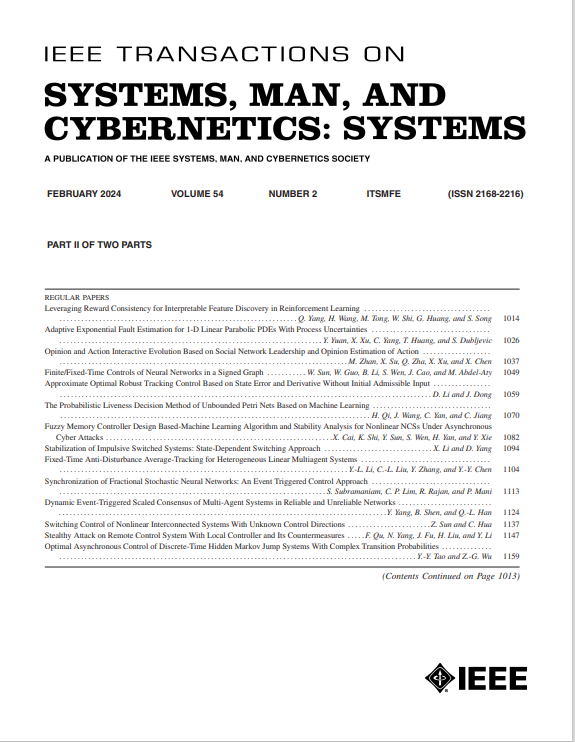Nested Optimized Adaptive Control for Linear Systems
IF 8.6
1区 计算机科学
Q1 AUTOMATION & CONTROL SYSTEMS
IEEE Transactions on Systems Man Cybernetics-Systems
Pub Date : 2024-10-08
DOI:10.1109/TSMC.2024.3467057
引用次数: 0
Abstract
The classical optimal control of the linear system assumes that the system is stabilizable, thereby deriving the optimal control with the outcome that the solution inherently stabilizes the system. Such optimization does not distinctly address stabilization and optimization as separate concerns, leading to a situation where, as the system expands in size and complexity, the optimal controller suffers performance decreases and becomes increasingly sensitive and fragile. In this article, nested optimized control (NOC) and nested optimized adaptive control (NOAC) are introduced to explicitly handle the stabilization, optimization/adaptation for unknown parameters separately in an effort to strike a balance between guaranteed stability and optimal control. The robustness of the classical optimal control is inherent in the design itself, and the stability margin is relatively small subject to parameter uncertainties. In our NOC, the robustness is explicitly handled by the state feedback control and its stability margin is larger than the classical one, because of the introduction of the explicit state feedback control loop, the next optimized control loop is introduced for system performance. Note that, the term optimized rather than optimal is used here as it is not the classical optimal control anymore, but a fundamental change in design methodology. To further improve the stability margin due to parameter uncertainties, adaptive control is introduced to approximate the parameters in an effort to further improve the stability margin. The effectiveness of the proposed method is demonstrated through comparative examples that highlight its advantages.线性系统的嵌套优化自适应控制
线性系统的经典最优控制假定系统是可稳定的,从而推导出最优控制的结果,即解决方案本质上能稳定系统。这种优化方法没有将稳定和优化作为两个独立的问题来处理,从而导致随着系统规模和复杂性的扩大,最优控制器的性能下降,变得越来越敏感和脆弱。本文引入了嵌套优化控制(NOC)和嵌套优化自适应控制(NOAC),明确地分别处理未知参数的稳定、优化/适应问题,力求在保证稳定性和优化控制之间取得平衡。经典最优控制的鲁棒性是设计本身固有的,在参数不确定的情况下,稳定性裕度相对较小。在我们的 NOC 中,鲁棒性由状态反馈控制明确处理,其稳定裕度比经典控制更大,因为引入了明确的状态反馈控制环路,为系统性能引入了下一个优化控制环路。需要注意的是,这里使用的是优化而不是最优,因为它不再是经典的最优控制,而是设计方法的根本性改变。为了进一步提高参数不确定性导致的稳定裕度,引入了自适应控制来逼近参数,以进一步提高稳定裕度。通过对比实例,展示了所提方法的有效性,突出了其优势。
本文章由计算机程序翻译,如有差异,请以英文原文为准。
求助全文
约1分钟内获得全文
求助全文
来源期刊

IEEE Transactions on Systems Man Cybernetics-Systems
AUTOMATION & CONTROL SYSTEMS-COMPUTER SCIENCE, CYBERNETICS
CiteScore
18.50
自引率
11.50%
发文量
812
审稿时长
6 months
期刊介绍:
The IEEE Transactions on Systems, Man, and Cybernetics: Systems encompasses the fields of systems engineering, covering issue formulation, analysis, and modeling throughout the systems engineering lifecycle phases. It addresses decision-making, issue interpretation, systems management, processes, and various methods such as optimization, modeling, and simulation in the development and deployment of large systems.
 求助内容:
求助内容: 应助结果提醒方式:
应助结果提醒方式:


